It’s about a 9 min. read.

I don’t envy the United Airlines (UAL) management team these days. Last month’s removal of passenger Dr. David Dao from an overcrowded plane in Chicago sparked a major PR nightmare for the airline carrier. This debacle comes to a brand that was already struggling from image problems in an industry that has long been comedic fodder for bad customer experiences.
Overbooking, heightened security procedures, skyrocketing baggage fees, and shrinking legroom have made domestic air travel a very stressful experience. With emotions running high on the tarmac, in the air, and on Twitter, what’s an airline to do?
Emotional analytics are a critical tool to help create a truly consumer-centric brand. Emotions are a key driver in consumer brand adoption/loyalty and will undoubtedly play a major role in how United performs going forward. In our self-funded study of the impact of emotions across 90 brands in 5 industries, CMB found that a brand’s overall emotional impact score can heavily influence future likelihood to purchase along with other key KPIs (advocacy, engagement, etc.).
We identified which specific emotions drive business outcomes in the airline industry, the top being “secure”, “efficient”, and “happy”. Of the negative emotions we tested, “anxious” proved to be the most damaging to a company:
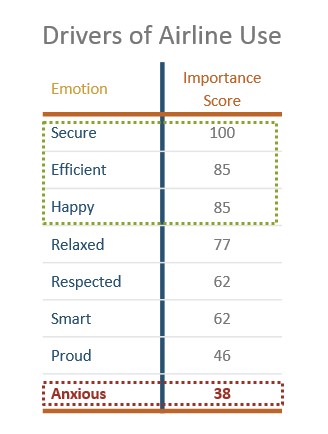
We also found that of the five major airline brands tested, including United, UAL had the lowest Net Positive Emotion Score (NPES). NPES is the balance of positive emotions activated through experience with a company subtracted by the extent of negative emotions activated. It also accounts for overall emotional “activation” (high vs. low), and the general sentiment of that activation (positive or negative).
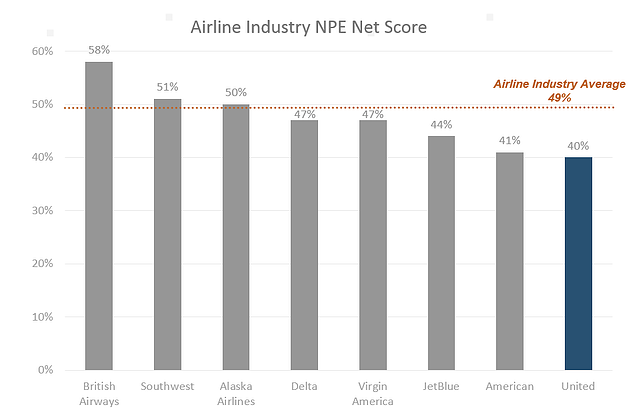
Both United and American both share a special place at the bottom of the “Negative Emotion” spectrum (17 and 18, respectively), out-activating negativity by ~30% over the airline industry average of 13.
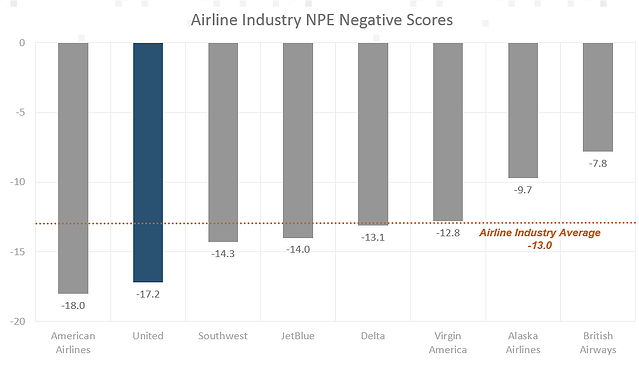
Now let’s have a look-see at what specific emotions have the biggest impact on likelihood to consider flying United, specifically, and how that compares to the overall industry average of emotional drivers:
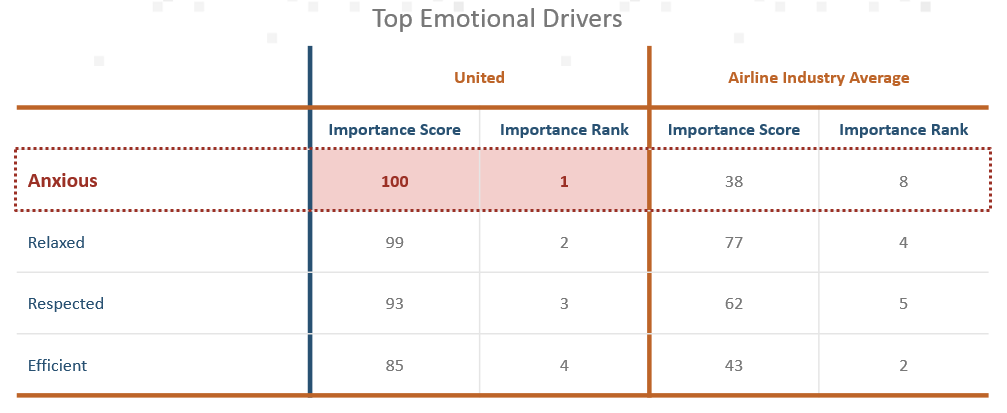
The “Anxious” vs. “Relaxed” emotional spectrum is the biggest emotional driver of future United purchase intent. Lowering feelings of “Anxiety,” in particular, is much more important for United’s brand than it is for the industry average.
Unfortunately for United, their brand already generated 33% more “anxiety” than the industry average:
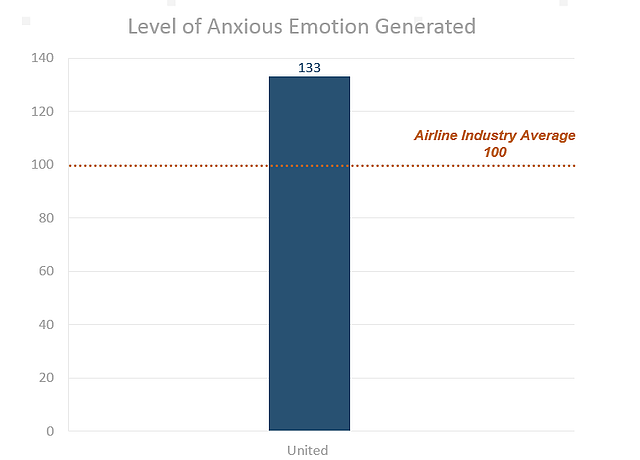
I can only imagine the anxiety Dr. Dao felt when he was removed from the seat he paid for to make room for a UAL employee. And I can also imagine the emotional connection felt by the millions of others who watched the video of him being dragged off the plane by airport security because they could relate to it in some way from their own travel experiences or common worries people have about flying:
No doubt this incident would have been a PR disaster for any airline, but the blowback was likely even more intense because it happened on a UAL flight—a brand that already activates more negative sentiments than most competing brands.
United Airlines was already in the hole before this incident, and now that hole is vastly deeper. Bad press and bad experiences linger longer in peoples’ memories than positive press or positive experiences, so it’s likely the image of Dao’s forced removal is here to stay (at least for a while).
Similarly, angry customers are much more likely to tell others about their bad experiences (typically with a bigger megaphone) than those with positive ones. Righteous indignation goes viral more readily than positivity. Furthermore, bad word-of-mouth has larger negative impact on a brand than good word-of-mouth has positive impact (by an order of magnitude). And some of the most prolific public haters will likely never be swayed otherwise, no matter what UAL does from this point forward.
In our analysis, we found that—across all industries tested—emotional reactions to the most recent experience have a much bigger impact on likelihood to buy in the future than the worst experience a customer has ever had with a brand (or the best). In other words, even brands that mess up big time can recover if they begin to deliver customer experiences and marketing communications strategies that foster the right emotions. With our “EMPACT” approach, we can identify very specific customer experiences, creative executions, and messaging that will deactivate the most damaging emotions like “anxiety” and activate key positive emotions like “relaxed.”
If United wants to be a truly consumer-centric brand, they need to consider emotion measurements like NPES as a valid metric for tracking and analytics. United will need to profoundly understand which emotions matter, and how to proactively influence these emotions through specific customer experiences, promotional campaigns, and influencing what is (and isn’t) said about the brand on social media.
Emotional metrics deserve the same level of visibility and focus that traditional industry metrics like Revenue Per Available Seat Mile (RASM) and classic NPS receive. Until this happens, UAL may struggle to focus their customer experience strategies and creative campaigns in a way that helps them recover from this low point.
Chris Neal leads CMB’s Technology & Telecommunications practice. He gets emotional very easily. He is also a frequent flyer on United Airlines. While extremely angered and disgusted by the viral video of the UAL incident, he is curious to experience how UAL actually changes in future and will fly this airline again to find out.